We love to talk about how to remove it, how to prevent it and signs you should look for if you suspect you have it.
However, once we get past those three topics there’s something else we really need to address and that’s toxic black mold. There is a lot of information out there about but it’s easy to get confused with what’s true and what might be a little overexaggerated.
Let’s get started.
Signs of Toxic Black Mold
There are a few clues and signs toxic black mold gives away when it’s growing in your home. Just like any other type of mold, it’s attracted to areas with higher moisture contents and available feeding sources.
This means your basement and your attic are prime real estate. Attics have extreme temperature swings and this allows for condensation to build up and basements have higher moisture content from being underground.
Because mold isn’t a picky eater, almost anything serves as a food source. This can be the structural beams in your home to your carpet, curtains and other fabrics.
Mold also gives off a distinctly musty odor. If you smell this in your home, there’s a good chance you’ve got some mold growth.
It’s important to note that mold is not always visible to the naked eye. It can grow in the smallest cracks and crevices, inside your air ducts and even inside your walls. Just because you don’t see it, it doesn’t mean it’s not there. That’s why it’s important to be aware of the previous signs I mentioned.
Toxic Black Mold and Allergy Symptoms
It’s often thought that everyone that is around black mold will have symptoms but that isn’t the case. Health symptoms only show up in those that are allergic to this particular type of mold and even then, the health symptoms can vary greatly.
For most people, the signs of a block mold allergy are similar to those of hay fever. You might have watery, itchy eyes, a runny nose or a scratchy throat. This is one of the reasons it makes toxic black mold harder to identify simply by the symptoms one exhibits.
For others, the health symptoms of toxic black mold are much more severe. These can be severe respiratory symptoms, headaches and migraines, and even depression. For a very long time no one connected these ailments to the existence of toxic black mold in a home or building, but now that the connection has been made many more people are aware of this type of mold.
What Are Your Next Steps?
Most people panic at the thought of toxic black mold growing in their house, and it’s understandable. When something is in your house that could be affecting your or your loved ones’ health, it’s important to get the situation under control.
However, many people, in a panic, either spend large amount of money for emergency removal services or they simply believe the only answer is to move. This is not the case.
While, yes, the situation needs to be taken care of immediately, it’s ok to take your time to weigh out your options and find a mold remediation plan that works with your timeline and budget.
That’s where we come in. We have a team of certified professionals who are ready to answer any questions you might have and work with you on a plan that works for you. Don’t panic. Instead, contact us today and let us help you get you and your family back on track to healthy and mold-free lifestyle.








